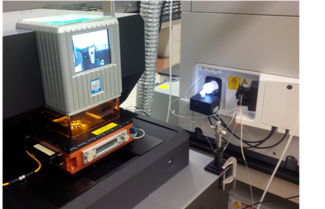Gas Flow Measurement System for ESI
Background Information
Electro Scientific Industries (ESI) uses a laser system that functions off of two different gases: helium and nitrogen. These gas flows are very important, and without them the system will not work properly. The laser system uses laser ablation on the front end of a mass spectrometer. After the laser vaporizes the material in a clean chamber, the helium gas stream delivers the sample to the mass spectrometer for measuring. The nitrogen gas is used in the laser optics train pathway to take moisture out of the pathway because the coatings on the optical lenses cannot work with any moisture. Currently the helium gas flow and pressure are measured on the front end, but no other gas flows are measured. Both gases flow at 0-3 liters per minute (LPM), which is very low. At these flow rates it is not reliable to try and feel the gas coming out of the tube or listen to it in order to make sure the flow is correct.
This brings us to the goal of our project: we need to design a low cost sensing system that is capable of measuring three gas flows; one for the helium exiting the system and both the entering and exiting ends for the nitrogen gas.
Purpose
Our design process is constrained primarily by finances and size. While solutions to this problem exist comercially, they are expensive and are not guaranteed to be small enough to fit in the alloted space. These various comercial sensors would also be more difficult to integrate into ESI's current system; designing the sensor ourselves does gaurantee that the gas flow measurement system will fit within the printed circuit board space available, work with the tubing size, and interface with the existing software systems.
The expectations of this project move beyond a working idea to a design that is ready to be manufactured and calibrated. All of the design work must be done with ESI's specific manufacturing process in mind, including things like location and machining or 3D-printing capabilities. A calibration test fixture will also have to be designed so that the client can check the valididty of their gas flow out in the field. A calibration procedure will also be written to accompany the calibration hardware.
Sponsor Information
Prof. David Dickensheets | College of Engineering | Department of Electrical and Computer Engineering
Dr. Dickensheets has been a part of the ECE faculty since 1997. His research interests include MEMS and MOEMS, optics, health care and industry.
Office: Cobleigh Hall 530
Tel: (406) 994-7874
Email: davidd@montana.edu
Leif Summerfield | Electrical Engineer | ESI | Bozeman, MT
Leif has worked with ESI since his undergraduate education at MSU. He designs laser ablation systems for analytical chemistry and material processing applications.
Office: 685 Old Buffalo Trail
Tel: (406) 586-3159 x 115
Email: lsummerfield@esi.com


